How to propagate an Alocasia Zebrina
Propagation is the easiest way to get more plants for free! In this guide, we'll go over a few steps you can take to to propagate an Alocasia Zebrina and to make it grow from a bulb to a fully-grown plant with a beautiful stem and big green leaf.
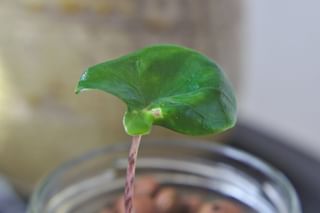
In this propagation guide, we'll go over what you can do with the Alocasia bulbs and how you can help them grow into small plants and fully-grown Alocasia Zebrinas. To help you figure out how to do this, we've divided this guide into 3 easy to follow steps. Once you understand how to take care of these bulbs, you'll have beautiful new Zebrinas in no time. The steps we're covering are:
Now, let's learn how to propagate these beautiful plants.
1. Harvesting the Alocasia Zebrina bulbs
Back to top Harvesting Alocasia Zebrina bulbs can be tricky or easy, depending on the growing medium you grow your Zebrina in. For those of you that grow your Alocasia in Leca, it's as simple as pulling the plant out and carefully removing the bulbs from the parent plant. Make sure the bulb comes off easily because only then is it ready to be harvested. If the bulb is still skinny and doesn't seem to come off easily, it's not quite ready yet.
For those of you who grow your Alocasia Zebrina in soil, the best time to check for bulbs is when it's time to repot your plant. If you're wondering when and how to repot your Alocasia Zebrina, you can read more about it in the guide "How to repot an Alocasia Zebrina". With soil, it's much easier to notice when you can harvest your bulbs because they usually just fall off when you clean the soil off the roots of your plant. Any bulbs that stay on the parent plant should remain on there because those might not be ready yet.
You can also let the bulbs grow without removing them from the parent plant. So if you don't want to remove the bulbs at all and just want to let the plant grow naturally, this is also an option for you. The main benefit of going with this option is that you won't really have to care for your bulbs in a special way. The parent plant will make sure the bulb grows and it will feed it. The Zebrina bulbs are very small and you can see what they look like in the image below.
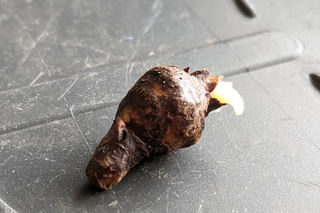
If your bulbs are thinner than this, that's not a problem. These will still grow properly if you take care of them well. In fact, one of my best growing bulbs is a very thin bulb that I didn't think would do well. Keep in mind that it could take a while before your bulbs start to grow roots. This really depends on what season it is at the moment. I harvested my bulbs in autumn and I don't recommend this. It took 4 months before the roots started to show up. This was a very long time. If you harvest the bulbs in the late winter or early spring, you will get roots much more quickly. So I recommend this period in the year to go through this process.
2. Taking care of the bulbs
Back to top Taking care of the Zebrina bulbs differs a little depending on the growing medium, once again. If you grow your bulbs in Leca, which is how I do it, you need to make sure the bulbs never sit in water. Ideally, you should clean the bulbs once per week or once per two weeks. This just ensures no fungus can take hold of your bulbs. You don't have to do this anymore once your bulbs grow roots, because they will absorb the water around it.
If you plan to grow your bulbs in the soil, make sure the soil is well-draining and let the soil dry out before you water it again. The goal is to give the bulbs the opportunity to grow roots by watering it when it gets dry, but not give it so much water that it'll start to rot. This is one of the reasons why I use Leca for this process. Leca helps to keep the moisture levels more consistent. This is definitely not a requirement though, so don't feel bad for using soil. Your bulbs will still do well in it.
As I mentioned earlier, it could take a while before your bulbs start to grow roots, so don't give up hope on them too quickly. The bulbs will reward your good care. When the roots do start to come in, the image below is what it will start to look like.
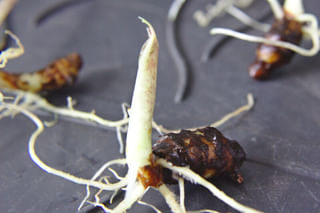
3. Taking care of baby Alocasia Zebrinas
Back to top After the bulbs start to grow roots, it won't take long before the stem starts to grow. The roots and stem usually start to grow at the same time, but it's not instantly clear which is the stem and which ones are roots. In the image above you can clearly see the stem, it's much thicker than the roots. When the roots start to get bigger, the plant becomes more self-sustaining and you won't have to do as much work as before. It now comes down to watering and fertilizing the plants properly.
When you grow the plants in Leca, the only thing you have to think about is not letting the bulb and roots sit in the water. With soil, you have to make sure the plant grows in well-draining soil, because it won't do well in wet soil. Fully-grown plants have beautiful thick stems that will store water that it needs to grow. This is also the case for the small plants. But there is a slight difference: the stems aren't as thick yet. In the image below you'll see the bulb and plants in the different stages of development.
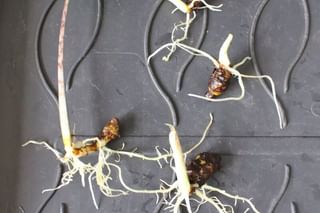
As you can see, the stems are thin and won't be able to contain a lot of water until the plants get bigger. Keep this in mind as you might need to check the moisture level of your soil more often. These plants should be kept in moist soil, but are allowed to dry out for a day. This will prevent the plant from drying out, but it will also help to not let the plant get root rot. This is another scenario where Leca could be beneficial. The only thing you have to worry about with Leca is to not let the roots sit in water. The Leca will regulate the moisture level for you and the plant will drink when it's thirsty.
Leaving the bulb on the parent plant
Back to top When you chose to keep your bulbs on the parent plant, you won't really have to do any special care for them. The parent plant will feed the bulbs and make sure they grow properly. After a while, the baby plants will peak out of the soil or Leca and it will let you know that everything went fine. In the image below you'll see a baby plant that's growing from the parent plant. It might look slightly different from the other plants that you have separated from the parent plant. The separated plants will have learned to feed themselves right away, and the other plants will have primarily been fed by the parent plant.
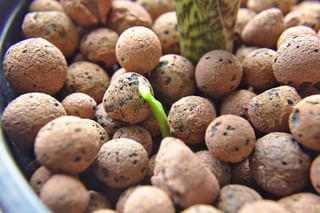
By separating the bulbs, you'll already have propagated your plants because they're now independent plants. The bulbs that are still connected to the parent plant could be separated after it grows bigger. It's just a matter of preference at this point. You could even choose to not separate the plant at all and let it grow as-is. This is technically not propagating, but you will get more new plants and stems from it.
Whichever way you choose to grow these bulbs, in the end, you will have a few extra beautiful plants. And the best part of this is that it was completely free. You get all of these extra plants for free. It might take a bit of work, but you'll be rewarded with new plants, and that's always worth it.
Conclusion
Propagation is the easiest way to get more plants for free. The Alocasia Zebrina grows new plants by growing bulbs at its roots. These bulbs can be harvested and planted separately, but you can also leave them on the parent plant. Both ways will have their advantages and their disadvantages, but in the end, you will have new, beautiful, plants. Using Leca to propagate your Alocasia Zebrina is the easiest way, but you can also do this with well-draining soil if that's what you prefer.
This guide will help you with what you need to do to care for these baby Zebrinas. By the end, you'll have all the knowledge you need to grow these plants from bulbs to fully-grown plants.
Thank you for reading this post! I hope it helps you to keep your plants healthy and beautiful! If you're looking for more guides on specific plants, you can always request a plant guide to get a guide for the plant you have trouble with.
Test your plant care knowledge
Quiz completed!
Want to learn more? Sign up for my newsletter to receive free tips in your inbox!
Sign up now!





